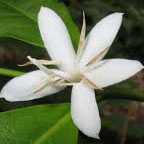Coffee is one of the most popular drinks in the world. Four out of five Americans drink coffee on a daily basis, consuming over 400 million cups per day. World-wide, the statistic is even more astounding: over 1.4 billion cups of coffee per day are brewed, poured, and then deliciously consumed. (And yes, you read that correctly: the number of cups is in the billions.)
But how many of us would even recognize a coffee tree if we stumbled across one in the jungle? How many of us could even describe its leaves, its bark, or its flowers?
Before working at a coffee company, I myself knew that coffee trees produces red cherries ~ but then, so do many other plants. I also knew that the caffeinated properties of the cherries were first discovered in Ethiopia ~ via the dancing antics of a bunch of hyped-up goats, so says the legend ~ which tells me something about the coffee tree’s history and habitat…
But really, considering the number of cups of coffee I have drunk in my life, my lack of knowledge of the plant itself is a silly, really. Oh, how removed from my food sources am I!
I hereby dedicate myself to learning the most basic facts about the coffee tree.
- The coffee tree is actually technically not a tree. It’s a shrub.
- It is a member of the flowering plant family Rubiaceae, which includes, among 13,000 other species, the very lovely gardenia and the very useful cinchona (whose bark contains quinine, used in the early treatment of malaria).

- Although members of the plant family Rubiaceae are found in every major region of the world except for Antarctica, most species are found in the humid tropics. Coffee shrubs themselves grow best between the Tropic of Cancer and the Tropic of Capricorn.
- The earliest fossil findings of Rubiaceae plants date from the Eocene era (roughly 56 to 34 million years ago), suggesting an origin even earlier in the Late Cretaceous or Paleocene era. (And for those of you who like dinosaurs, the Eocene era is when the mighty race of huge lizards finally died out. Exit Tyrannosaurus Rex, enter Emmenopterys, the now-extinct fruit-bearing grandparent of today’s flowering Rubiaceae!)

- Of all the Rubiaceae species, the Coffee shrub, including both the Robusta and the Arabica varieties, is the most economically important. (Coffee is actually the second most-important commodity on the earth, second only to oil! Beyond ideologies, societies, and ambitions, our world is ostensibly powered by two black liquids, both with interesting and ancient histories!)
It goes without saying there are many more facts we could list here, but this is a good start. Coffee shrubs come from a long and glorious lineage of plants, and I have a greater respect for them than I ever did before. I consume their fruit on a daily basis without a single thought to their species and taxonomy. But maybe now, every once in a while, I’ll pause over the rim of my mug and remember that I’m partaking of the fruit of a plant family that outlived the dinosaurs. The dinosaurs, people!


